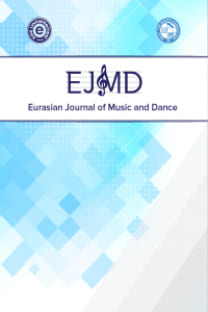KEMAN CİLASINDA ‘GELENEKSEL YÖNTEM’ VE ALKOL BAZLI CİLA İÇİN BİR UYGULAMA ÖRNEĞİ
Geleneksel yöntemlerle hazırlanan keman cilaları, hazırlanmalarında kullanılan reçinelerin çözünürlük tipleri bakımından üç şekilde kategorize edilmiştir. Bunlardan ikisi alkol ya da yağda çözülebilen ayrı reçinelerle üretilmeleri nedeniyle birbirinden ayrılmakta, ‘alkol’ ya da ‘yağ’ cilaları şeklinde adlandırılmaktadır. Bununla birlikte hem alkolde hem de yağda çözülmeye uygun bazı reçinelerle üretilebilen ‘karışım’ ya da ‘yağ temelli’ (Setragno, 2017 s. 80) olarak adlandırılan cila uygulamaları da bulunmaktadır. Bu makalede amaç, alana ilişkin kaynaklardan yararlanma yoluyla, bu makale aracılığıyla kullanımına yer verilecek malzemeleri temel özellikleri açsından tanımlamakla birlikte, ‘geleneksel’ yöntemin takip edildiği, alkol temelli bir cilanın hazırlanması ve uygulanması aşamalarına ilişkin bilginin aktarımı ile, ‘çalgı bilim çalışmalarının bir kolu olarak ülkemiz ‘çalgı yapım alanına’ ilişkin bilgi havuzuna, uygulamalı organoloji kapsamında ufak bir katkıda bulunmak olacaktır. Söz konusu sebeple bu çalışma, etnomüzikoloji ve halkbilim alanlarında kendisine hali hazırda oldukça geniş bir yer bulmuş durumdaki ‘gelenek’ ile ilgili kuramsal tartışmanın aktarımına girmek yerine, daha çok çalgı yapım alanının ‘edimsel’ yönünü beslemeyi tercih eder. Bununla birlikte söz konusu alana akademik çalışma üretme yönünden dahil olmayı amaç edinen gençler için ‘mesleki’ olarak tüketilen herhangi bir bilginin akademik bir makale aracılığıyla ortaya konuşunu ve paylaşımını örneklemeyi hedefler.
Anahtar Kelimeler:
Keman, cila, İtalya, gelenek, alkol cila
Traditional Method in Violin Varnish and an Example for the Application of the Alcohol-Based Varnish
The violin varnishes based on traditional methods are categorized under three types according to the resins’ dissolvability. Two of these are separated from each other based on the fact that they are produced using different resins dissolved in alcohol and oil, and they are called ‘alcohol’ or ‘oil’ varnishes. In addition to this, there are varnishes prepared by some resins appropriate to be dissolved both in alcohol and oil, and these are called ‘mixture’ or ‘oil based’ varnishes (Setragno, 2017, 80). The aim of this article is both to define the basic qualities of the materials which are operated through this article and to contribute to the knowledge pool of our country’s ‘instrument making field’ in terms of applied organology through the transmission of the information related to the preparation and application processes of an alcohol-based varnish according to traditional methods. Thus, this article prefers to feed the ‘practical’ side of the field of instrument making instead of transmitting the theoretical discussion about ‘tradition’ which has a quite broad place in the fields of ethnomusicology and folklore. The article also aims to exemplify the exposition of any information consumed ‘professionally’ via a scholarly article for the young practitioners who are willing to be included in the aforementioned field by producing academic works.
Keywords:
Violin, varnish, Italy, tradition, alcohol varnish,
___
- Barlow, C.Y. & Woodhouse, J. (1989). Of Old Wood And Varnish: Peering Into The Can of Worms. Journal of Catgut Acoustical Society, vol. 1, no: 4, 2-9.
- Burnett, T.G. (1852). An Encyclopedia of Useful and Ornamental Plants, “Pistacia Lentiscus-Mastic Tree”.
- Condax, M. Louis (1968). “Examination of the Ground Layer of the Italian Violin Varnish”. Catgut Acoustical Society Newsletter.
- Dery, J. (2012) Investigating Shellac: Documenting the Process, Defining the Product, Project-Based Masters Thesis, The Institute of Archeology, Conservation and History, Faculty of Humanity, University of Oslo.
- Hammerl, R. Hammerl, J. (1970). Violin Varnishes. Hammerl, Baiersdorf.
- Heron-Allen, (1885). Violin-Making, As It Was And Is, New York: Ward, Lock & Co., Limited, Warwick House, Salisbury Square, E.C.
- Hurst, George H. (1901). Dictionary of Chemicals and Raw Products Used in the Manufacture of Paints, Colours, Varnishes and Allied Preparations. Scott Greenwoodand Co. London.
- Kolneder, Walter (2003). The Amadeus Book of The Violin. New Jersey: Amadeus Press.
- Reeder, G. John (1983). Summary of Trade and Tariff Information. Usitc Publication 841.
- Setragno, Francesco vd., (2017). Feature-Based Analysis of the Impact of Ground Coat and Varnish on Violin Tone Qualities, Acta Acustica United with Acustica, vol. 103, 80-93.
- Shellacfinishes (2010). Shellac Origins and Manufacture. Erişim tarihi: 21.01.2020. https://www.youtube.com/watch?v=lQcQ0yuekZ0
- Wake, H.S. (1994). The Technique of Violin Making. Connecticut: Wake Publishing.
- Wake, H.S. (1996). The Luthiers Scrap Book. Connecticut: Wake Publishing.
- ISSN: 2651-4818
- Yayın Aralığı: Yılda 2 Sayı
- Başlangıç: 2011
- Yayıncı: Ege Üniversitesi
Sayıdaki Diğer Makaleler
20. YÜZYILIN İLK YARISINDA İZMİRDE DİNİ MUSİKİ BESTECİLERİ
KEMAN CİLASINDA ‘GELENEKSEL YÖNTEM’ VE ALKOL BAZLI CİLA İÇİN BİR UYGULAMA ÖRNEĞİ
Attila ÖZDEK, Sami Emrah GEREKTEN
GOMİDAS: HAYATINA, DERLEMELERİNE VE DERLEMELERİNDEKİ DANS EZGİLERİNE BİR BAKIŞ
BİR KÜLTÜRÜN DÖNÜŞÜMÜ: “POSTTÜRKÜ”
Sadık ÇALIŞKAN, Derya KARABURUN DOĞAN
ERCİŞ “DEMELİ-ÇEVİRMELİ” TÜRKÜ SÖYLEME GELENEĞİNDE ÖZGÜN FORMLAR VE YENİ TANIMLAR
